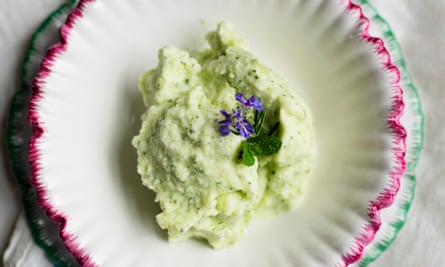Easter, whether early or late, is the point at which my cooking changes step. The lidded earthenware casseroles are put away until autumn; the jars of beans in the larder are moved to the top shelf – almost too high to reach – and slow cooking is swapped for suppers that take a few minutes on the grill. The last few days before Easter is when I make a deep casserole of beans, onions and sausages – the final big casserole, with which to wave goodbye to winter-spring.
Of all the jars of beige pulses on the larder shelves, it is black-eyed beans which are the most infrequently used, though I’m not quite sure why. Much as I enjoy the slow-food ritual of soaking dried beans overnight and cooking them from scratch with bay leaves and onion, I am more likely to choose a tinned or bottled variety for a weekday dinner.
Bean-based meals are worth making the day before. They reheat successfully and often seem to get better after a night in the fridge. I use a deep casserole, usually of cast iron, that can be left to simmer quietly on the hob. If yours is made of earthenware, then I suggest starting off in a stainless-steel saucepan then, once the liquid is added, transferring it to the casserole dish and baking at 180C/gas mark 4, for 40 minutes.
The first herb up this spring has been the mint. (It is usually tarragon, but not so this year.) A healthy plant that has been growing in a pot on the kitchen steps for a year or two now. I pinched a handful of stems for a seasonal ice, the first in a while – chopping the leaves finely and steeping them in a light sugar syrup before freezing. Mixed with yoghurt in place of custard they produced the most refreshing of desserts. One that I have been known to trickle a little melted chocolate over on occasion.
Sausages and black-eyed beans
I use plump, heavily seasoned sausages here, perhaps the fat Italian sausages thick with fennel, black pepper or chilli that you find in Italian delis. They have a coarse, open texture and take particularly well to long, slow cooking. Failing that, a good butcher’s breakfast sausage will do the job admirably. Serves 4. Ready in 90 minutes
onions 3, medium
olive oil 3 tbsp, plus a little extra
garlic 3 cloves
black-eyed beans 2 x 400g
bay leaves 3
fennel seeds 2 pinches
black peppercorns 8
pork sausages 8 (see above
medium-dry sherry 1 full wine glass
dessert apples 2
plain flour 2 tbsp
stock 750ml
thyme 6 bushy sprigs
grain mustard 2 tbsp
parsley 4 sprigs
Peel the onions, cut them in half and then into thick slices. Warm 3 tbsp of oil in a deep pan, add the onions and cook them over a moderate heat until they are soft and golden. Stir regularly so they colour evenly.
While the onions are cooking, peel and finely slice the garlic, then add it to the softening onions together with the bay leaves, fennel seeds and peppercorns.
When the onions are soft and sticky, remove them from the pan and add a little more oil. Cut the sausages into short lengths, then add them to the pan and let them colour nicely on all sides.
Return the onions to the pan, add the sherry, continue to cook for a couple of minutes, then stir in the flour. Cook for a further 2 or 3 minutes, then introduce the hot stock, tuck in the thyme sprigs and continue cooking for 25 minutes.
Core and thickly slice the apples and add them to the simmering hotpot. Season with salt, black pepper and the mustard. Continue cooking until the apples are soft and beans are tender enough to crush between finger and thumb. If you wish, finely chop the leaves of a few sprigs of parsley and stir in at the end.
Mint frozen yoghurt

As much as I appreciate my ice-cream machine, I also like recipes that don’t require one. The sort of ice you can pop in the freezer without churning and simply stir thoroughly every few hours until frozen. This bright green, refreshing ice is one those. You just need a deep freeze and a freezer box. It helps the texture of the finished water-ice if you can remember to beat the mixture with a fork or small whisk every hour or so as it freezes, though this is not essential.
Serves 8. Ready in 1 hour using an ice-cream machine, longer in the freezer
granulated white sugar 250g
mint sprigs 10g
mint leaves 10g
water 250ml
yoghurt 400ml
Put the sugar and half the mint sprigs, leaves and stalks, into a food processor. Pulse until you end up with moist, green sugar. Put the green sugar and water into a saucepan and bring to the boil. As soon as all the sugar has dissolved, remove it from the heat and quickly cool the mixture – either by putting the pan in a sink of cold water or, as I do, by pouring the syrup into a bowl set in a larger one full of ice cubes.
Blitz the remaining mint briefly with the yoghurt, then stir into the cooled syrup and mix gently. Pour the mixture through a fine sieve into the bowl of an ice-cream machine or chilled plastic freezer box. If using a churn, then mix until almost frozen. If you are using the freezer method, place in the freezer for a couple of hours or until ice crystals start to form on the edges, then stir or whisk them into the liquid centre and return it to the freezer. Repeat once, an hour or so later, then leave until almost frozen. Serve the mint-ice in small bowls.
Follow Nigel on Instagram @NigelSlater

.png) 1 day ago
8
1 day ago
8













































